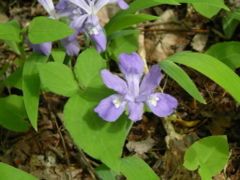Iris crisata
| Iris crisata subsp. var. | ||||||||||||||||||||||||||||||||||||||||||||||||||||||||
|---|---|---|---|---|---|---|---|---|---|---|---|---|---|---|---|---|---|---|---|---|---|---|---|---|---|---|---|---|---|---|---|---|---|---|---|---|---|---|---|---|---|---|---|---|---|---|---|---|---|---|---|---|---|---|---|---|

|
|
| ||||||||||||||||||||||||||||||||||||||||||||||||||||||
| ||||||||||||||||||||||||||||||||||||||||||||||||||||||||
Iris cristata (Crested Iris) is of the genus Iris, subgenus Limniris. In North America, it is native to areas of the Eastern United States. It is a close relative to Iris lacustris which is the only other crested iris native to North America, but which is found only in small areas of the Great Lakes region which have been glacier-free for only 11,000 years.
| Standard Cyclopedia of Horticulture |
|---|
|
Iris crisata, Soland. Plant dwarf: rhizome slender, creeping: lvs. ensiform, thin, 4-8 in. long, green: st. 1-3 in. high, flattened, 1-headed, bearing 2-3 lvs.: tube slender, l ½ -2 in. long; limb blue; outer segms. obovate, 1 -1 ½ in. long, crested; inner segms. shorter, naked. April, May. Mountains of Ky., Va., and the Carolines.
The above text is from the Standard Cyclopedia of Horticulture. It may be out of date, but still contains valuable and interesting information which can be incorporated into the remainder of the article. Click on "Collapse" in the header to hide this text. |
Cultivation
Propagation
Pests and diseases
Varieties
Gallery
-
photo 1
-
photo 2
-
photo 3
References
- Standard Cyclopedia of Horticulture, by L. H. Bailey, MacMillan Co., 1963
External links
- w:Iris crisata. Some of the material on this page may be from Wikipedia, under the Creative Commons license.
- Iris crisata QR Code (Size 50, 100, 200, 500)
